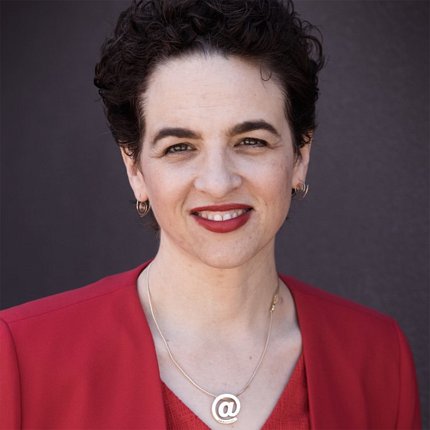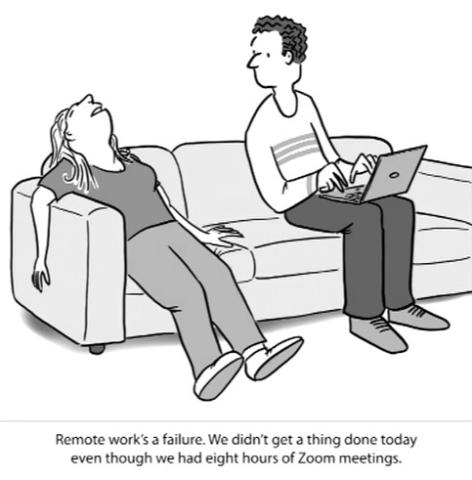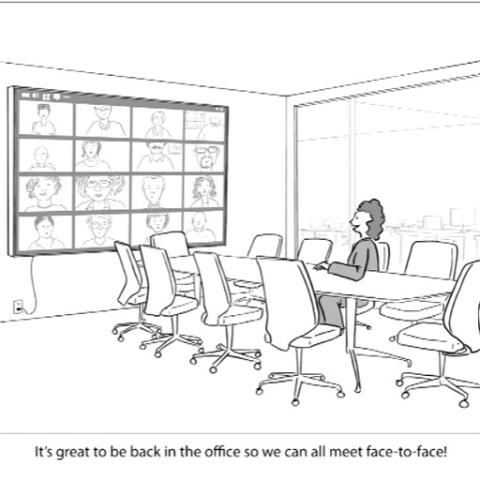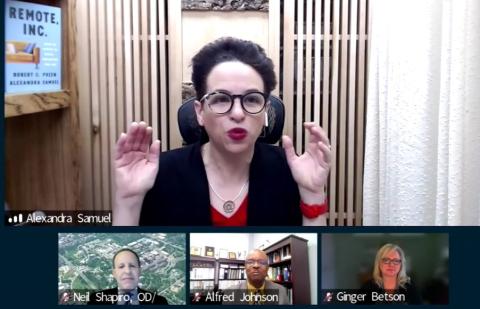Nix Needless Meetings
Samuel Gives Tips on How to Thrive in the Hybrid Workplace

The future of work has arrived. This new normal—a hybrid of on-site and remote work—that largely emerged during the pandemic is still new for many workers and doesn’t always feel normal.
Offices everywhere are trying to adapt to this hybrid model, improvising and tweaking to create a workplace that optimizes productivity and morale. To help navigate the challenges, Dr. Alexandra Samuel, digital workplace strategist and author, offered advice at a recent Deputy Director of Management Seminar Series lecture.
This new reality is not new for Samuel, who has worked hybrid for 20 years. For everyone else now going hybrid, she said, seize this opportunity to reinvent the workplace.
“When I think about hybrid work, I think about moving to a world of work where we no longer assume a one-size-fits-all version of the office,” said Samuel. “We should be asking every single person on our team: ‘What do you need to work effectively?’”
Many are finding the workplace more accessible in the new world. People with chronic health issues, for example, might do their best work remotely. For Samuel, who has a child with autism, workplace flexibility has been especially meaningful.
“This opening of different ways of working could make it possible to have a more inclusive and more equitable workplace,” she said.
Of course, the needs of managers and employees can clash in the hybrid world. “There will be moments where we have to make evaluations and tradeoffs and compromises,” said Samuel.
Now is the time for managers and employees to begin an ongoing dialogue about needs, routines, work-life balance and sustainability.
“At the end of the day, the only way to really protect your mental health, your energy levels, your long-term sustainability is to recognize that you have to draw some lines for yourself,” Samuel said.
Many workers report frequently working extra hours in the evening because it’s the only time they can get work done. The culprit? Too many meetings.

Photo: Rob Cottingham
It’s time to rethink meetings in our workday, underscored Samuel. “Stop treating meetings as the default way of getting things done,” she said.
When scheduling meetings, or replying to attend them, stop and think: Is there another way to plan and get this work done? Consider the array of tech tools that foster collaboration without meeting or even working at the same time. “Even if we replace one in five meetings,” she said, “it’s a start.”
That array of tech tools, though, can be daunting. The key is knowing and agreeing on when to use which channels.
Document-sharing platforms help to brainstorm, outline, share and plan. “And you may get a wider range of ideas from more people if there’s time and space to reflect,” said Samuel.
Instant messaging and Teams discussion forums facilitate short-term, time-sensitive, real-time exchange on a shared platform. Email can help colleagues manage multiple tasks and share information, while providing a trackable record.
“The more you can get this structured input in asynchronous ways…not having to reply in real time,” said Samuel, “the more you give people the tools to manage their own time and attention.”
A hybrid environment begs the question: What needs to get done in person and what can get done at home?
“If we’re doing hybrid, it’s because we recognize there is unique value in us being together face to face,” Samuel said. Try to schedule meetings on those days when the team is in the office together, she advised. On remote days, ideally there would be no or few meetings, allowing time for uninterrupted, focused work.

Photo: Rob Cottingham
“Having real flexibility to manage your own time on days you’re not in the office is worth so much more than being able to set your own schedule only to have the privilege of coming in and having meetings in an empty room,” she said.
In fact, Samuel discourages holding hybrid meetings. “If it’s essential to have [certain] people in the meeting, you want to level the playing field,” she said.
If some people are in the office and others are remote, have everyone do a video meeting, she advised. Each person should be in front of a computer with the camera on so everyone can easily follow and participate. Perhaps sign into the virtual meeting a few minutes early to allow for informal chitchat.
If hybrid meetings can’t be avoided, have what Samuel calls a Zoom buddy. “Each remote person should have someone [physically] in the room whose job it is to keep them engaged.”
Going remote and hybrid requires flexibility and a shift in mindset. Supervisors must shift from watching the clock to managing outcomes. Trust the team to deliver results without constant oversight.
In this new world, Samuel said, the manager is “the mentor; the clearer of bottlenecks; the person we bounce ideas off of; the person who can connect different resources within the team so people can get their work done” wherever they are.
That mindset is a big part of sustaining the organization’s culture and mission. “When organizations promote that interpersonal trust,” she said, “we’re able to get more done; our work is more satisfying and it [helps prevent] burnout.”

Samuel recommends doing a self-audit in each team. Think about the team’s pre-pandemic practices for onboarding, fostering collegiality and communicating mission.
“Think about ways to update or riff on these practices so they work in this new world,” she said. Have that chitchat before virtual meetings. Maybe plan a monthly activity for the team.
Foster the transition equitably from onsite to remote and hybrid. Explore ways to mentor and train employees at all levels so everyone can build meaningful relationships and has the tools and the opportunity to thrive and advance their careers.
This hybrid world is here to stay. How can it become an optimal work environment for everyone?
“The beauty of this moment where we’re rethinking the very nature and structure of the workplace is that we can normalize this conversation,” said Samuel.
“Finding ways to build trust, relationships and connection while we’re not all in the same place, while also creating enough space and independence in our time at home so we can regenerate, is part of our work.”
